If you're new here, you may want to subscribe to my RSS feed. Thanks for visiting!
By Daisy Luther
When you think about economic collapse, you probably envision all sorts of issues: food shortages, soup lines, people living in their cars, and abject poverty.
But the reality is, many of the things that will personally affect you are those day-to-day conveniences that we take for granted. So many things are automated in our modern way of life that we don’t even consider what our ancestors had to do to keep their homes running smoothly.
Most of us prepare so that we can smoothly deal with whatever comes our way. Part of the Preppernomics series will discuss day-to-day tasks that may change for us in the near future. This week, we’re going to talk about doing your laundry without the help of a washer and dryer.
Why would you need to do this?
We all know that anything that can go wrong, often does go wrong. While you may have a perfectly functioning washing machine now, that doesn’t mean it will always be available.
- What if water is rationed? It takes about 30-45 gallons of water to do a load of laundry in a machine.
- What if the power goes out?
- What if your washing machine malfunctions and you can’t afford to fix it?
- What if you depend on the laundromat, but you’re out of money?
- What if you can no longer stay in your home for some reason, and the place you’re staying doesn’t have a laundry facility?
- What if you’re simply trying to cut all costs to the bare minimum, including limiting your use of public utilities?
In any of the above scenarios, being able to do your laundry by hand is a good skill to have. There’s more to it than dunking your clothes in some soapy water. Read on for complete instructions.
If you’ve never washed a load of clothing by hand, it can seem like a daunting task when you’re faced with a pile of dirty sheets, jeans, and stained socks. We had to do this up at the cabin for the first 6 months we lived there, until we finally (thankfully!) got a washing machine. It’s hard work – the wet laundry is heavy, wringing it out is hard on your hands, and it’s time-consuming to scrub each item separately. There are some shortcuts and pieces of equipment that can make it easier. It’s a good idea to gather these specialty items now, when times aren’t as tough and they are easily accessible.
Creating Your Off-Grid Laundry Facility
There are a few pieces of equipment that can greatly lessen your work. In the old days, the lucky family had a washing machine similar to this one:
In fact, you can still get one of those if you happen to have $729.00 plus $100 shipping lying around. Check out Lehman’s if this is within your budget because it’s truly a great machine.
However, for the rest of us, there are other options.
Wonderwash Mini Washing Machine
My life would have been so much easier during those 6 off-grid months if I had owned one of these at the time. Not only are they much easier to use than leaning over the bathtub with a scrub brush, they use a lot less water. This machine uses about 1-2 gallons per load. You can’t do a huge load – maybe 4-6 clothing items at a time, but the ease of use means that you still get done faster than doing one big load manually. You can also easily collect your gray water by placing the spout over a reservoir. I love mine! I used it during a recent power outage to immediately wash a white shirt that had a cup of coffee spilled on it. The shirt came out spotless in just a few minutes.
It doesn’t spin your clothes so you still have to wring them out – more on the wringing below.
Best of all, at the time of this posting, this washing machine is less than $50 at Amazon, with free shipping. You really want this machine. Trust me.
Clothes Wringer
If you have one of those large plastic or metal laundry room sinks – the freestanding kind, this wringer will clamp onto the side for you. I haven’t been able to swing one of these yet, but it would certainly make life easier. The worst part about doing laundry by hand is, to me, the wringing. My hands used to ache by the end of a load of jeans or sheets, and they still dripped everywhere, even after wringing them for what seemed like ages.
It’s pricey at $175 (at time of posting) but it’s well worth it if you can afford it. The reviews at Amazon are excellent.
Commercial Mop Bucket
For those of us with a smaller budget, a janitor’s bucket works well for wringing out clothing. You’ll still need to do a small amount of wringing by hand, but it will be far easier than doing the whole process by hand.
I like this option because it can serve multiple purposes, it’s on wheels so it’s way easier to move your gray water to where you want it, and it’s a far lower price than the wringer above. If you never take another piece of advice that I offer, take this one. GET A COMMERCIAL GRADE MOP BUCKET. You might be tempted to try and save a few dollars with a less expensive bucket. Don’t do it! It will NOT hold up to the rigors of laundry. The wringers on commercial buckets are built to much higher standards and made of heavier materials than the cheapo buckets at your local Wal-Mart.
This one is very similar to mine and is less than $65 at the time of posting. Amazon is offering free shipping on this product.
Washboard
For those extra dirty items (like socks) nothing will get them cleaner than an old-fashioned washboard. I don’t recommend the plastic ones that are built into a small tub. If you have a large item like a pair of jeans or a towel, it’s difficult to maneuver your laundry with those. This one is super-sturdy and is made of wood and galvanized steel. It’s very vintage looking and makes a nice decorative statement on your laundry room wall, too.
At the time of this posting, this washboard is less than $25 on Amazon (with free shipping.)
 Scrub Brush
Scrub Brush
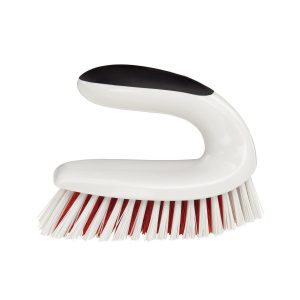
Agitator
This contraption resembles a toilet plunger, but you can see on the bottom that it’s specially designed to pull water through the fabric. It really helps get your clothes much cleaner if you’re doing them by hand in a tub or bucket. (The ad says this can be used in a 5 gallon bucket, but I’ve personally only used it in a bathtub full of laundry.)
This agitator is less than $20 at the time of this article, with free shipping from Amazon.
Clothes Drying Rack
A drying rack is not an absolute necessity, but depending on the time of year, your set-up, and how well you wring things out, it can be a definite boon to your off-grid laundry set-up. This particular design can hold an entire load of laundry in a very small amount of space. Ours sits in the bathtub, hidden behind the shower curtain. I use it all the time, not just during grid down scenarios, for those items I don’t want to put in the dryer.
The heavy-duty drying rack displayed is just under $30 on Amazon, with free shipping.
How do you wash clothes by hand?
Let’s go with the most minimal amount of supplies possible. You can use your bathtub, laundry tub, kitchen sink, or a couple of large buckets.
First, gather your supplies:
- Laundry soap of choice (I use my homemade laundry soap)
- Baking Soda
- Hydrogen Peroxide
- Sturdy scrub brush
- Small bucket (I use a clean plastic kitty litter bucket)
- Janitor’s bucket with a press wringer
- Drying rack and clothespins (or method of choice)
Once you have your supplies gathered, you’re ready to wash clothes!
Here is the step-by-step:
- Fill your tub. Whatever container you’re using for laundry, fill it with hot soapy water and put in your laundry.
- Let it soak. You can let the laundry soak anywhere from half an hour to overnight. Unless your clothes are very, very dirty, you won’t have nearly as much scrubbing to do after this.
- Agitate the laundry. I have used a broom handle for stirring the laundry around, but there are items that look similar to a toilet plunger designed specifically for the purpose of agitating laundry. You can even put the kids in there with clean bare feet to stomp all over your laundry (think about that grape-stomping episode on I love Lucy
to get the appropriate mental image.)
- Scrub the laundry.Use a scrub brush and a combination of laundry soap and baking soda. This is where an old fashioned washboard would come in handy, but if you don’t have one, just use the bottom of the bath tub. Pay special attention to “dirty” areas: around collars, underarms, knees, soiled kitchen linens, socks, and undergarments.
(Random, off-grid laundry tip)For the love of all things cute and fluffy, don’t wear white socks. I’ve learned that no matter how hard I scrub, nothing short of a tub full of bleach water gets our white socks looking clean, even though in terms of “sanitation” they are very clean. Investing in black socks for the stockpile will save you a lot of work, should a long-term electrical disaster ever take place.
- Some items require another session of soaking. I use homemade “oxygen cleaner” in my bucket for this: 1/8 cup each of baking soda, hydrogen peroxide and laundry soap and approximately a half gallon of hot water.
- Drain and refill your laundry tub. Some people add more laundry soap here but I feel like the soap on the clothing from scrubbing it is sufficient for this time around. Then allow it to soak again. I usually leave it for a couple of hours while I do other things. After the first hour, dump your items soaking in the treatment bucket into the big tub, along with the liquid in the bucket, and give it another stir.
- Rinse your laundry. Rinse your soaking bucket and drain the tub. Gently squeeze out the clothing items and let that water run down the drain or into a catchment system for flushing water. This will get some of the soap out. Add clean water to the tub, just enough to cover the laundry again. Rinse each item by swishing it vigorously through the water, then place it in the bucket that you soaked items in.
- Wring it out. Place your rinsed laundry into the wringer section of your mop bucket. Squeeze it out. Change the position of the item and squeeze it out again. This doesn’t get your clothing wrung out as well as the spin cycle on the washing machine, but it’s far more effective than wringing it out by hand. (Not to mention, way easier on your hands!) You can reuse this water by adding it to your collection of graywater.
- It’s still going to drip. No matter how well you wring out your laundry, it’s still going to drip for hours. I learned a little tip from my friend, Lizzie Bennett, who authors the British website, UndergroundMedic.com: Place your drying rack in the bathtub for a few hours. This keeps your floors dry and keeps your home from becoming excessively moist. In the UK, few people have dryers, so most people air dry their clothing indoors in the bad weather. I usually let the laundry drip in the tub overnight.
- Move it to a better place to dry.After that, I relocate it outside, weather permitting, or by the woodstove.
This is a good skill to learn now, because in a down-grid situation, when water could be limited for a multitude of reasons, you don’t want to waste your supplies and still have laundry that isn’t very clean.
The mental aspect of being able to don fresh clean clothing in the aftermath of a disaster or during a stressful situation cannot be underestimated. Clean clothing is a sign of normalcy and will benefit your well-being. Even more importantly, good hygiene will help prevent the spread of disease.
Do you have an off-grid laundry set-up?
Do you have plans in place for washing clothes without your machine? Do you have some tips based on your own experience? Please share them in the comments section below.

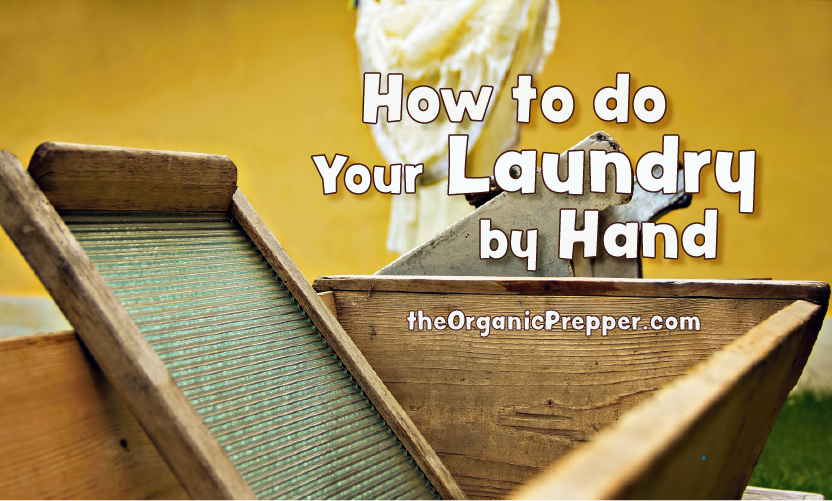
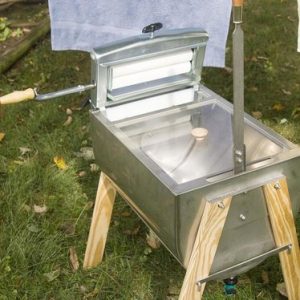
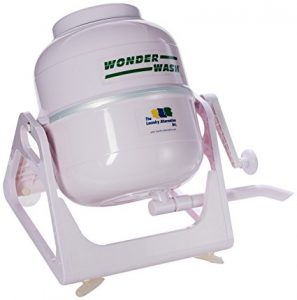
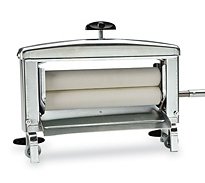
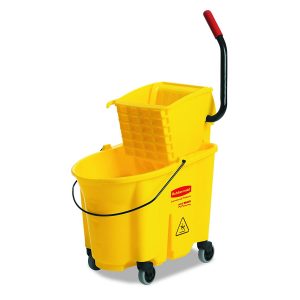
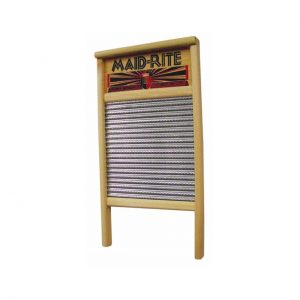
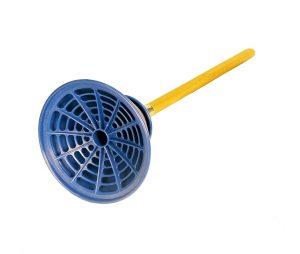
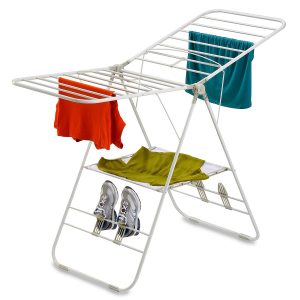














20 Responses
We have a wringer washer that we run on solar power. I’ve washed by hand, but that gets rough when there are six of us. The wringer uses a lot less water than a conventional machine, and the water can just be dumped outside. Like you, we all wear black (or gray) socks. Nothing stays white around here. My husband wears navy and black work clothes. Our biggest issue is the humidity. Most of the time, no matter what time of year, laundry needs to be hung over the wood stove in order to dry. I really want a separate wash house with a little stove in it.
We have a wringer, several washboards and a couple of agitators. These were all purchased in antique stores or flea markets. I also have a couple of huge wooden drying racks that fold up nicely.
Thanks for the tip on the commercial mop bucket. That should make it easier on my hands.
When I was a kid, we had a washer in the basement that Mom had to fill with a hose. There were two faucets on the wall for hot and cold and a drain in the floor. The washer was electric and it agitated, but we had to run the clothes through a wringer.
Then she had two wash tubs on a stand for rinsing. We used a broom handle to stir them. She would put bluing in the final rinse tub for whites.
Then we carried the clothes up the stairs from the basement and hung them outside to dry. My job was to run a wet rag down the clothes line to clean off the bird droppings.
We also had to cook starch for the clothes. Not sure if you can buy starch that way anymore. Then we had to iron things. We kept the damp clothes waiting to be ironed in the freezer until we were ready for them. We also had an old soda pop bottle with a sprinkler top to sprinkle the clothes as we ironed.
What a job! Thank goodness there were only three of us.
I recently read on Mother Earth News about putting up a clothes line in the greenhouse during the winter. Sounds like a good idea as the temps in the greenhouse are usually quite a bit higher than the outside temp and it is also dry in there.
“We also had to cook starch for the clothes. Not sure if you can buy starch that way anymore.” You could gather and cook your starch by grating potatoes, without the skins. Gather the starch at the bottom of the bowl (it will be obvious) putting it in water and cook it. You could also cook corn starch and use that.
This video uses a different method.https://www.youtube.com/watch?v=xqwdcUY32rA
There are others out there. I usually do not starch much anymore. My husband’s dress shirts for church come out of the dryer damp and when hung and dried, are wrinkle free. I do not iron the cloth napkins as they do not need it. I grew up in the era of everything needing ironing, and although I do not mind ironing, it is time consuming and only iron what I need to.
…have all of the above equipment…but am using a daily process that means washing something every day…just takes a few minutes and prepares me for some long term need.
Each person in the house showers or bathes every day. I have only one person who has to be dragged to the tub. The rule is:anything you take off must be put away or washed and dried and put away. Any underwear is washed while I am washing self. You can either keep the undergarmetns on and do this or take them off and wash by hand. 6 gallon pail and whisper washer in the shower with you and fill up with water as you shower and anything else goes in there and is hand washed while you are drying off. Then clothing is hung over drying racks or if need be for now…popped into a dryer.
I heard about doing this from a Mormon site: Missionary Mall, where they had a handout you can ask them for for free, and it teaches young people leaving home for 2 years about taking care of durable clothing and that was 1 thing they mentioned. I make all of my own body/shampoo bar soap and it’s a fabulous soap. Once the kids and everyone else started using this they never went back to liquid soap. It also does a fine job on the clothing. If they need to use a bleach they have to put it in the 6 gallon pail and use the whisper washer. It takes me about 3-5 minutes per day to wash my own clothing. Im in Nursing and my uniforms get trashed, so being able to put really hot water and a disinfectant as well in a 6 gallon pail makes very light work. I generally use the time well, to listen to the news, scriptures, etc.,while doing this. Now that its a habit, It’s no different than brushing my teeth. Because of this we never have any dirty laundry.
I have a white cutlace table cloth that often needs to be bleached. I get up from the table and as the table is being cleaned I shake this out the door and try to rub out the stain with hand soap and cold water, then just put it in a 10 gallon bucker with whisperwasher, bleach and a little homemade soap and let it sit….I walk back through the pantry area and give it a little agitation and then rinse in the sink or another bucker and wring it out and hang it up…takes allof 4-5 minutes total and all the while I am talking with family or planning my next move…it’s all habit!
There is probably nothing I hate more than standing in a wash room, folding laundry and sorting clothes…never again!
I do not mind folding laundry. I do not sort laundry other than household goods (I only buy TP) as each of my children were introduced to the washing machine, dryer/wash line/ and or iron at an appropriate age. They are all now adults and on their own.
I listen to pod cast while I am folding.
I do not feel it is necessary to take a bath or shower everyday. Bathing at the sink is a tried and true method of many generations. It saves on water consumption as well as towel use. We are a once and done towel use family, but you are much less dripping wet with a sink bath than getting out of the tub/shower. Saving on water and towel use, however, is **not** our motivation. It is very easy to dawdle in a shower!
I’m really intrigued by your system and I agree that things should never pile up. But what exactly is a whisper washer? I’ve googled and can’t find anythng that could fit.
I’m always on the lookout for info about handwashing and am looking to put together a self sufficient system. I live in Canada in the country and I’m not new to the concept. I suppose it’s the wringing aspect that’s kept me from doing more hand washing. I find I’m not able to do what I used to be able to manage. I’m also trying to move to Europe but still want to be self sufficient. I was dismayed to find that lehmann wouldn’t ship outside the US, or if that just applies to that gorgeous washing machine?
Great post!
Monica
In the winter, place several dowel rods across the top of the tub. Use hangars for shirts, etc, and other items just throw over the rods and let the tub catch the drips.
It’s possible to get 4 rods across the tub.
When we have had long power outages, (one week and two weeks), we used the generator to run the electric for enough time for washing a load or two and some hot showers. Both times it was rather cold; the freezers were not a problem at that point. We did not have any problems with heat.
We are canning more food to reduce the amount of food in the freezers to prevent any problems in the future, specifically outages that may occur in the heat/summer.
We have a wringer washer that can run with a small engine.
I have washed clothing by hand, and still do for small batches, and hang the items in the bathroom. It isn’t the hand washing that is a challenge, the wringing is a bummer. At this point, I much prefer to use the electric washing machine. When the time comes that I must use my hand washing skills and equipment that I own, I will use them. In the meantime, I will save my hands and time. It is the dryer that uses a lot of energy. We only use this appliance in the damp weather. We have an assortment of really nice drying racks. Drying clothing in the house adds much needed moisture that the heat takes away.
Definitely something many preppers overlook is washing clothes. The washing shouldn’t be difficult, but a plentiful supply of safe water would be advisable. In dem olden days, they would place clothes in a nice, boiling pot of water (helps with possible parasites)
that’s something to note that boiling water thing: people don’t realize how we are suddenly going to be noticing the bug population in SHTF. They’ve also done studies proving how clothes are actually not as clean now as they used to be because people are using cold water cycles etc…fecal matter getting transferred, white clothes not sanitized, and unless you are using high heat drying, dust mites, lice, fleas surviving.
Alternate drying (especially during rainy summers) that I picked up in the former Tightwad Gazette…set up drying racks or permanent lines in your attic. Even during clouds/rain, it’s hot enough in a traditional “attic” to dry even jeans in an hour or so.
So true… but in dem olden days they had fabrics that coyly stand up to dat boiling water.. lol.. I often think wistfully on how much better things probably were way back when… but we must admit that while modern clothing is cheap and crappy, it IS comfortable.. and I wouldn’t trade my trailored stretch blouses that don’t need ironing for anything… lol.
Monica
I like to hang up my clothes to dry, then soften and fluff for 10 minutes in the dryer. It saves electricity, ironing time and effort, and most importantly my clothes don’t shrink and last much longer then they do if I heat and tumble them for an hour. The extra moisture is a plus as well.
I have a laundry tub washboard scrubber but maybe need to look into something better. Lots of good ideas here, thanks.
I have the washtubs, hand wringer, racks, etc. and used to do the laundry that way. Now I just keep it around for emergencies, but I was eyeballing something recently that might work even better than the standard mop bucket wringer. The spin mops, like this –
http://smile.amazon.com/O-Cedar-Easy-Wring-Bucket-System/dp/B00COXDGQG/ref=sr_1_2?ie=UTF8&qid=1422631079&sr=8-2&keywords=o+mop
The foot operated centrifuge looks really efficient at getting the water out, even if you could only do one or two items at a time. I haven’t tried one yet, but I have tried the electric spinners and they’re really effective.
Can I use the Oxygen bleach recipe on dark clothes? Thank you
I use this on all of my laundry and have had no issue with fading. 🙂
Just wondering, what laundry detergent would you use in the situation where you run out and couldn’t get anymore ingredients? (grid down etc)
There are quite a few recipes out there for homemade detergent. You could use some common ingredients like salt and homemade soap to come up with something that would work pretty well. 🙂
I got free used detergent pails from my local laundromat that does laundry orders for x amount per pound. I know the manager, and I know that she saves the soap buckets, so I just called her and asked her if she had any. I got a dozen, with lids …all I had to do was pick them up. For a Dasher, I got a plunger at the dollar store, and I have a shower curtain tension rod across the back of the tub to hang laundry on. The last load I did was a pair of jeans, three housedresses, a nightgown, six pairs of socks and four pair of underwear. It took maybe twenty minutes, half hour of actual processing, not counting soaking time for really dirty items. It’s winter, so the heat is on and the air is dry, so everything dried overnight.
The best part is, I don’t have to contend with balky equipment or neighbors who hog the laundry room!
I built a pedal powered washing machine out of a cast off bicycle, a modified plunger, two, 5 gallon buckets, some skinny boards and assorted hardware. Two minutes of relaxed pedaling cleaned adult jeans quite well
The contraption does a couple other jobs as well.
Yes, I am washing my laundry by hand, partly because my finances are THAT bad, and partly for grid-down skill. I bought one of those expensive wringers and I am not very happy with it because it did not attach to the sink or anywhere convenient. I might return it. But it is faster and less muscle strain than twist wringing, and most things do not drip.
I am trying to reconfigure it to fit on my sink divider, and I might be happier with it then.
Also, I pour my bucket of washed clothes into a large steel colander. Most of the water drips out after a while, reducing the wringing work, whether hand or wringer.